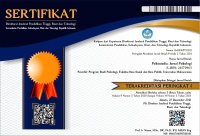The Illegal Racing Community Phenomenon: A Case Study of the Meaning of Toxic Masculinity Behavior in Krian
Abstract
Often illegal racing activities are considered as meaningless activities and cause negative impacts by the wider community, but this actually creates a positive side for the perpetrators. This study aims to see how toxic masculinity behaves and what are the benefits to the wild racing community. The method used is a qualitative research method with a case study approach, with analysis using coding techniques. The subject of this study used 4 participants, namely the four participants were perpetrators of illegal racing in the Krian area and supported by 4 participants as significant others. Based on the results of the analysis of the four participants, it shows that the behavior of toxic masculinity arises due to the masculine factors possessed by the perpetrators. Toxic masculinity behavior is indicated by the presence of self-esteem, self-actualization, and affiliation. Self-esteem is shown because participants feel they have courage and feel disapproving when they are insulted by others. Self-actualization is indicated by the emergence of potentials that arise when participants take part in wild racing. Affiliates appear with behavior that supports each other, becomes a support system, and motivates each other. These three behaviors arise because they are influenced by self, family, social and economic factors.
Seringkali kegiatan balap liar dianggap sebagai kegiatan tidak bermakna dan menimbulkan dampak negatif oleh masyarakat luas, namun hal ini justru menimbukan sisi positif bagi para pelakunya. Penelitian ini bertujuan untuk melihat bagaimana perilaku toxic masculinity dan apa manfaat pada komunitas balap liar. Metode yang digunakan adalah metode penelitian kualitatif dengan pendekatan studi kasus, dengan analisis menggunakan teknik koding. Subjek penelitian ini menggunakan 4 partisipan, yaitu keempat partsipan tersebut adalah pelaku balap liar di wilayah krian dan didikung oleh 4 partisipan sebagai significant others. Berdasarkan hasil analisis keempat partisipan menunjukkan bahwa perilaku toxic masculinity muncul dikarenakan adanya faktor maskulin yang dimiliki oleh para pelaku. Perilaku toxic masculinity ditunjukkan dengan adanya self-esteem, aktualisasi diri, dan afiliasi. Harga diri dutunjukkan karena partisipan merasa memiliki keberanian dan merasa tidak terima ketika dirinya dihina oleh orang lain. Aktualisasi diri ditunjukkan dengan munculnya potensi-potensi yang muncul ketika partisipan mengikuti balap liar. Afiliasi muncul dengan perilaku yang saling mendukung, menjadi support system, dan saling memotivasi antara satu dengan yang lainnya. Ketiga perilaku tersebut muncul karena dipengaruhi oleh faktor diri sendiri, keluarga, lingkungan sosial, serta ekonomi.
Keywords
Full Text:
FULL TEXTReferences
Achilleos, C. (2019). Gender and Queer Perspectives on Brexit. In Gender and Queer Perspectives on Brexit (Issue January 2019). https://doi.org/10.1007/978-3-030-03122-0
Akbar, R. S., Aulya, A., Psari, A. A., & Sofia, L. (2019). Ketakutan Akan Kehilangan Momen (FoMo) Pada Remaja Kota Samarinda. Psikostudia : Jurnal Psikologi, 7(2), 38. https://doi.org/10.30872/psikostudia.v7i2.2404
Al Falaq, J. S., & Puspita, D. (2021). Critical Discourse Analysis: Revealing Masculinity Through L-Men Advertisement. Linguistics and Literature Journal, 2(1), 62–68.
Albrecht, M. M. (2020). ‘You wonder ever if you’re a bad man?’: Toxic masculinity, paratexts and think pieces circulating around season one of HBO’s True Detective. Critical Studies in Television, 15(1), 7–24. https://doi.org/10.1177/1749602019893575
Barry, J. (2020). Reactions to Contemporary Narratives about Masculinity: A Pilot Study. SSRN Electronic Journal. https://doi.org/10.2139/ssrn.3734314
Bowman, P. (2020). In toxic hating masculinity: MMA hard men and media representation. Sport in History, 40(3), 395–410. https://doi.org/10.1080/17460263.2020.1756394
Budiastuti, A. &, & Wulan, N. (2017). Konstruksi Maskulinitas Ideal Melalui Konsumsi Budaya Populer oleh Remaja Perkotaan. Mozaik Humaniora, 14(1), 8.
Chatmon, B. N. (2020). Males and Mental Health Stigma. American Journal of Men’s Health, 14(4). https://doi.org/10.1177/1557988320949322
Christensen, J. K., Henderson, J. D., Dorn-Medeiros, C. M., & Lertora, I. (2019). Navigating Toxic Masculinity in Clients as a Beginning Therapist. 264–283. https://doi.org/10.4018/978-1-7998-0022-4.ch013
Daddow, O., & Hertner, I. (2021). Interpreting toxic masculinity in political parties: A framework for analysis. Party Politics, 27(4), 743–754. https://doi.org/10.1177/1354068819887591
de Boise, S. (2019). Editorial: is masculinity toxic? Norma, 14(3), 147–151. https://doi.org/10.1080/18902138.2019.1654742
Deliyanni, V., Tereškinas, A., Bekkaoui, K., Reddad, S., & ... (2018). Gender, identities and education.
Elliott, K. (2018). Challenging toxic masculinity in schools and society. On the Horizon, 26(1), 17–22. https://doi.org/10.1108/OTH-11-2017-0088
Falcão, T., Macedo, T., & Kurtz, G. (2021). Conservadorismo e masculinidade tóxica na cultura gamer: uma aproximação a Magic: The Gathering. MATRIZes, 15(2), 251–277. https://doi.org/10.11606/issn.1982-8160.v15i2p251-277
Farizky, H., & Setyowati, R. N. (2015). FAKTOR PENDORONG REMAJA MENGIKUTI BALAP LIAR DI JALAN KARANGMENJANGAN SURABAYA Hardika Farizky 094254017. Kajian Moral Dan Kewarganegaraan, 2. file:///C:/Users/HP/Documents/Balap/12008-15604-1-PB.pdf
Frąckowiak-Sochańska, M. (2021). Men and Social Trauma of Covid-19 Pandemic. the Maladaptiveness of Toxic Masculinity. Society Register, 5(1), 73–94. https://doi.org/10.14746/sr.2021.5.1.04
Hakim, L., & Purwoko, B. (2016). Explorasi Self Esteem Pelaku Balap Liar Pada Siswa SMP Di Kabupaten Exploration Self Esteem the Perpetrators of Racing of Junior High School Student in Mojokerto. Jurnal BK UNESA, 6(3), 1–9.
Harsin, J. (2021). Aggro-truth: (Dis-)trust, toxic masculinity, and the cultural logic of post-truth politics. Communication Review, 24(2), 133–166. https://doi.org/10.1080/10714421.2021.1947740
Hess, A., & Flores, C. (2018). Simply more than swiping left: A critical analysis of toxic masculine performances on Tinder Nightmares. New Media and Society, 20(3), 1085–1102. https://doi.org/10.1177/1461444816681540
Hines, E. M., Jr, E. C. F., Ford, D. Y., & Iii, J. L. M. (2021). Preserving Innocence : Ending Perceived Adultification and Toxic Masculinity Toward Black Boys Preserving Innocence : Ending Perceived Adultification and Toxic Masculinity. 21(1).
Huion, P., & Ayçiçek, M. H. (2021). Not All Migrant Men Embrace Toxic Masculinity, Do They? Rivista Italiana Di Educazione Familiare, 19(2), 41–50. https://doi.org/10.36253/rief-10521
Imanuddin, F., & Tola, B. (2017). Harga Diri Dan Agresivitas Pembalap Liar. JPPP - Jurnal Penelitian Dan Pengukuran Psikologi, 2(1), 15–24. https://doi.org/10.21009/jppp.021.03
Ingram, K. M., Davis, J. P., Espelage, D. L., Hatchel, T., Merrin, G. J., Valido, A., & Torgal, C. (2019). Longitudinal associations between features of toxic masculinity and bystander willingness to intervene in bullying among middle school boys. Journal of School Psychology, 77(December 2018), 139–151. https://doi.org/10.1016/j.jsp.2019.10.007
Jufanny, D., & Girsang, L. R. M. (2020). Toxic Masculinity Dalam Sistem Patriarki (Analisis Wacana Kritis Van Dijk Dalam Film “ Posesif ”). Jurnal Semiotika, 14(1), 8–23.
Mabrouk, D. M. M. (2020). The Dilemma of Toxic Masculinity in Eastern and Western Societies; With Reference to the Novel “Men in Prison.” Open Journal of Social Sciences, 08(06), 419–437. https://doi.org/10.4236/jss.2020.86032
Mahendra, I. (2017). Stereotip Gender Dan Penyebaran Wacana Maskulinitas Dalam Novel Balada Si Roy: Joe Karya Gola Gong. Alayasastra, 13(2), 105—118.
Martinez, M. (2021). Toxic Masculinity: An Outcome of Colonialism and its Effects on the Latinx/Chicanx LGBTQ+ Community. McNair Research Journal SJSU, 17. https://doi.org/10.31979/mrj.2021.1711
Matahari, R. G., & Putra, Y. Y. (2019). Kontribusi Sensation Seeking Terhadap Risk Taking. Jurnal Riset Psikologi, 1–12.
Muntafi, M. S. (2022). Speeding Behavior Among Young Motorcyclists : The Role of Theory of Planned Behavior Variables and Willingness. 11(1), 158–168. https://doi.org/10.30872/psikostudia
Pamungkas, A. W., & Handoyo, P. (2016). Makna Balap Liar di Kalangan Remaja (Komunitas Balap Liar Timur Tengah Motor Mojokerto). Paradigma, 4, 1–6.
Pearson, E. (2019). Extremism and toxic masculinity: The man question re-posed. International Affairs, 95(6), 1251–1270. https://doi.org/10.1093/ia/iiz177
Petković, D. (2018). Heteronormativity and Toxic Masculinity in Stephen Dunn’s Closet Monster. AM Journal of Art and Media Studies, 16, 43. https://doi.org/10.25038/am.v0i16.253
Sculos, B. W. (2017). We are the Beast: On Toxic Masculinity and Social Responsibility in Disney’s Beauty and the Beast. Class Race Corporate Power, 5(2). https://doi.org/10.25148/crcp.5.2.006511
Simões, R. B., Amaral, I., & Santos, S. J. (2021). The new feminist frontier on community-based learning: Popular feminism, online misogyny, and toxic masculinities. European Journal for Research on the Education and Learning of Adults, 12(2), 165–177. https://doi.org/10.3384/RELA.2000-7426.3359
Ue, T. (2022). Toxic masculinity and the college scene: John Berardo on Initiation and the anti-establishment thriller. Journal of Gender Studies, 31(2), 280–286. https://doi.org/10.1080/09589236.2021.1931825
Wantona, A., Janah, N., & Rosita, D. (2020). Fenomena Remaja Melakukan Balapan Liar di Kota Takengon. Jurnal Ilmiah Mahasiswa Bimbingan Dan Konseling, 5(1), 55–67.
Wikström, M. C. (2019). Gendered Bodies and Power Dynamics: The Relation between Toxic Masculinity and Sexual Harassment. Granite Journal, 3(2), 28–33.
DOI: http://dx.doi.org/10.30872/psikostudia.v11i2.7528
Refbacks
- There are currently no refbacks.
Copyright (c) 2022 Psikostudia : Jurnal Psikologi

This work is licensed under a Creative Commons Attribution-ShareAlike 4.0 International License.
Indexing by :
_________________________________________
PSIKOSTUDIA: Jurnal Psikologi Published by Faculty of Social and Political Siences, University of Mulawarman, Samarinda, East Kalimantan and This work is licensed under a Creative Commons Attribution-ShareAlike 4.0 International License.
_________________________________________
PSIKOSTUDIA: Jurnal Psikologi
Department of Psychology
Faculty of Social and Political Siences, University of Mulawarman
Jl. Muara Muntai Kampus Gn. Kelua Samarinda 75411
Phone: +62 813 35350368
E-Mail: psikostudia@fisip.unmul.ac.id




















